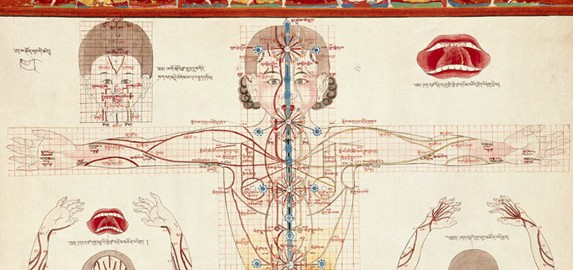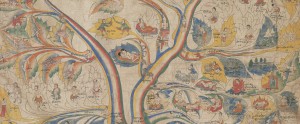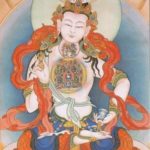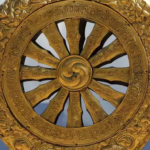Living an inspired, compassionate life depends on cultivating vitality in body and mind. Through understanding our body, we can minimize and eliminate some of the most persistent obstacles to our spiritual life.
Pema Khandro’s teachings specialize in the integration natural medicine with Buddhist practice. A practitioner of Tibetan medicine and Ayurveda, she founded the Yogic Medicine Institute within which she co-directs a school and clinic. Tibetan Yoga and meditation, nutrition and cleansing practices are essential tools to renew ourselves on a regular basis and to discover what it is to be fully alive.
An Introduction to Tibetan Medicine – the Body Mind Connection
by Pema Khandro (Excerpted from a Lecture)
Synchronizing body and mind is one of the major benefits of meditation practice. The more we pay attention to our bodies the more we may find that our physical sensations can be a natural key to discovering presence. But Buddhism doesn’t stop there. Body-mind connection and body-mind mediations are central features of esoteric Buddhism.
Body in Sutra, Tantra and Dzogchen
The idea of a body – mind connection is one that runs deeply through east asian religious thought. For westerners, body and mind are often assumed to be a duality. In the case of the great perfection (Dzogchen), the body and mind are both expressions of an underlying reality. This may be surprising to you if you have heard teachings from early Buddhism which talk about the body in negative terms. The body is a rotting corpse, a bag of pus, blood and bones, one should not be tempted by the desires of the body and so forth… But later developments in Buddhist tantra developed more body positive imagery. In the great perfection teachings, the Body is believed to have Buddha-nature, it is made of the same stuff of the universe, which is pure and good by nature.
Body in Tibetan Medicine
Buddhist culture saw an integration of religious, philosophical and medical perspectives. This is why, in the study of Tibetan Medicine, Buddhist influence is readily apparent. Notions of karma, beliefs about dying and death and understanding of the subtle body in Tibetan Medicine all reflect Buddhist paradigms. So there is considerable overlap. One of the key areas of overlap is the belief that our body, whether healthy or diseased, is influenced by past karma. Past karma is considered one of the factors that causes disease. There are also karmic illnesses which cannot be cured through medicinal substances, diet or physical treatments. Instead they require ritual intervention and religious treatment.
Subtle Body – The Body of Mind
The interconnectedness of the Body and Mind in Tibetan medicine is based on a system of symbols. Generally the body’s internal anatomy is described in terms of three channels and four to seven centers which govern physiological and psychological functions. This system is different than western anatomy because it doesn’t emphasize the material or physical body. Instead it is a way of conceiving how the mind works. It is a set of symbols that describes the interrelationship of the mind and body. So it attempts to do something more abstract than western anatomical projects do. The symbols used to describe the body are richly layered with meanings connected to Buddhist philosophy, cosmology and meditation.
The Body’s Ecosystem
Tibetan Medicine holds that one’s physical health is a product of numerous factors. It is not just one thing. As already mentioned, ignorance and karma are prime influences in the disease process. This means un-virtuous actions in the past can lead to poor health. This reminds me of a Tibetan friend of mind who had a stomach ache one day. I offered him a digestive pill and he declined. Instead he went to go make amends for a wrong he had committed in order to free himself of the negative karma. Psychological traumas would also fit in this category of past negative karma. It is a different way of thinking than the western medical concept, however even western medicine is now tuning into how our relationships and emotional states are a key factor in health. Three of the major mental factors in health are grasping, hatred and closed mindedness. These states not only cause psychological suffering, but they also are considered causes physical illnesses.
The paradigm of the “three humors” are a way of organizing the physical world and its relationship with the individual. These are known as wind, phlegm and fire. Each of these corresponds with the body’s internal functioning and external environment. A body which is more metabolic, with a quick mind, propensity for inflammation and sharp appetite could be said to be governed by the “fire” humor. A body which is depleted, weak or anxious could be said to have an excess of “wind” humor. A body which is phlegm dominated could have more excess moisture, stagnation or mass. The concepts of wind, phlegm and fire summarize groups of symptoms, as well as qualities of food and even body-types. By having a lifestyle or diet that does not harmonize with the three humors in one’s own inner ecology, one disturbs the inner ecosystem and this leads to illnesses. Therefore in Tibetan Medicine, the first line of healing begins by addressing diet and lifestyle factors. Then when necessary, herbal supplementation and healing techniques can also be introduced to detoxify the body and bring it back into balance.
Why this matters – Meditation & Tibetan Medicine
Tibetan Buddhism highlights the interconnectedness of our body and mind. If the mind is easily agitated, or very dull, these are states that can be addressed through diet and lifestyle practices. Buddhists carry the wish to be sane, kind and present. That can be difficult when the body is pain, when the mind is racing or when moods are unpredictable. Therefore utilizing Tibetan Medicine principles can help to reduce obstacles to Buddhist meditation and practice. Meditation has powerful physiological effects. However trying to clear all the physical problems through meditation is like trying to paint a house with a crayon. Yes it will do the job, but in many cases, it could be much more effective to apply herbal, dietary or lifestyle remedies. Then, the power of meditation can be focused on overcoming those blocks which herbs, diet and lifestyle cannot. The two practices of physical health and spiritual development are natural partners.
______________
Read about the Yogic Medicine Institute, founded by Pema Khandro Rinpoche here
You will find more articles by Pema Khandro about Tibetan Medicine here.
You will find answers to frequently asked questions about practice and study with Pema Khandro here.
Follow Pema Khandro on Facebook here








